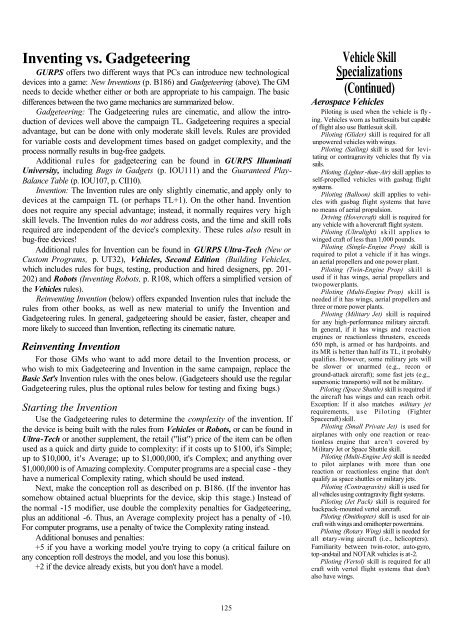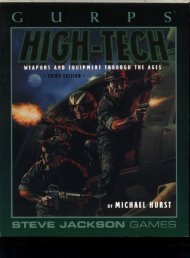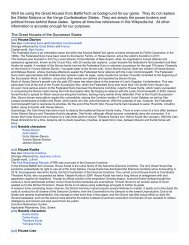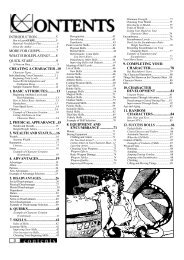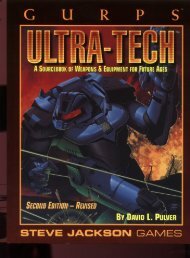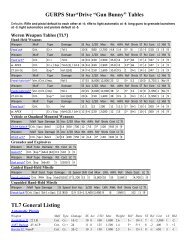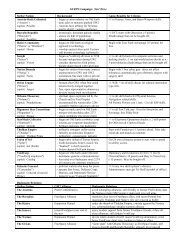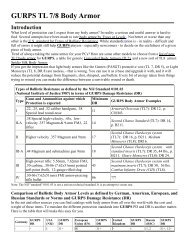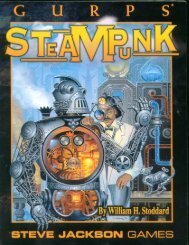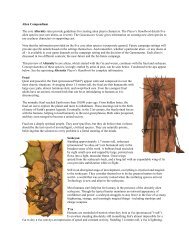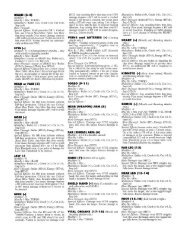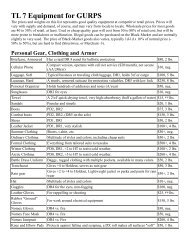GURPS - Compendium 1..
GURPS - Compendium 1..
GURPS - Compendium 1..
You also want an ePaper? Increase the reach of your titles
YUMPU automatically turns print PDFs into web optimized ePapers that Google loves.
Inventing vs. Gadgeteering<br />
<strong>GURPS</strong> offers two different ways that PCs can introduce new technological<br />
devices into a game: New Inventions (p. B186) and Gadgeteering (above). The GM<br />
needs to decide whether either or both are appropriate to his campaign. The basic<br />
differences between the two game mechanics are summarized below.<br />
Gadgeteering: The Gadgeteering rules are cinematic, and allow the introduction<br />
of devices well above the campaign TL. Gadgeteering requires a special<br />
advantage, but can be done with only moderate skill levels. Rules are provided<br />
for variable costs and development times based on gadget complexity, and the<br />
process normally results in bug-free gadgets.<br />
Additional rules for gadgeteering can be found in <strong>GURPS</strong> Illuminati<br />
University, including Bugs in Gadgets (p. IOU111) and the Guaranteed Play-<br />
Balance Table (p. IOU107, p. CII10).<br />
Invention: The Invention rules are only slightly cinematic, and apply only to<br />
devices at the campaign TL (or perhaps TL+1). On the other hand. Invention<br />
does not require any special advantage; instead, it normally requires very high<br />
skill levels. The Invention rules do not address costs, and the time and skill rolls<br />
required are independent of the device's complexity. These rules also result in<br />
bug-free devices!<br />
Additional rules for Invention can be found in <strong>GURPS</strong> Ultra-Tech (New or<br />
Custom Programs, p. UT32), Vehicles, Second Edition (Building Vehicles,<br />
which includes rules for bugs, testing, production and hired designers, pp. 201-<br />
202) and Robots (Inventing Robots, p. R108, which offers a simplified version of<br />
the Vehicles rules).<br />
Reinventing Invention (below) offers expanded Invention rules that include the<br />
rules from other books, as well as new material to unify the Invention and<br />
Gadgeteering rules. In general, gadgeteering should be easier, faster, cheaper and<br />
more likely to succeed than Invention, reflecting its cinematic nature.<br />
Reinventing Invention<br />
For those GMs who want to add more detail to the Invention process, or<br />
who wish to mix Gadgeteering and Invention in the same campaign, replace the<br />
Basic Set's Invention rules with the ones below. (Gadgeteers should use the regular<br />
Gadgeteering rules, plus the optional rules below for testing and fixing bugs.)<br />
Starting the Invention<br />
Use the Gadgeteering rules to determine the complexity of the invention. If<br />
the device is being built with the rules from Vehicles or Robots, or can be found in<br />
Ultra-Tech or another supplement, the retail ("list") price of the item can be often<br />
used as a quick and dirty guide to complexity: if it costs up to $100, it's Simple;<br />
up to $10,000, it's Average; up to $1,000,000, it's Complex; and anything over<br />
$1,000,000 is of Amazing complexity. Computer programs are a special case - they<br />
have a numerical Complexity rating, which should be used instead.<br />
Next, make the conception roll as described on p. B186. (If the inventor has<br />
somehow obtained actual blueprints for the device, skip this stage.) Instead of<br />
the normal -15 modifier, use double the complexity penalties for Gadgeteering,<br />
plus an additional -6. Thus, an Average complexity project has a penalty of -10.<br />
For computer programs, use a penalty of twice the Complexity rating instead.<br />
Additional bonuses and penalties:<br />
+5 if you have a working model you're trying to copy (a critical failure on<br />
any conception roll destroys the model, and you lose this bonus).<br />
+2 if the device already exists, but you don't have a model.<br />
Vehicle Skill<br />
Specializations<br />
(Continued)<br />
Aerospace Vehicles<br />
Piloting is used when the vehicle is fly -<br />
ing. Vehicles worn as battlesuits but capable<br />
of flight also use Battlesuit skill.<br />
Piloting (Glider) skill is required for all<br />
unpowered vehicles with wings.<br />
Piloting (Sailing) skill is used for levitating<br />
or contragravity vehicles that fly via<br />
sails.<br />
Piloting (Lighter -than-Air) skill applies to<br />
self-propelled vehicles with gasbag flight<br />
systems.<br />
Piloting (Balloon) skill applies to vehicles<br />
with gasbag flight systems that have<br />
no means of aerial propulsion.<br />
Driving (Hovercraft) skill is required for<br />
any vehicle with a hovercraft flight system.<br />
Piloting (Ultralight) skill applies to<br />
winged craft of less than 1,000 pounds.<br />
Piloting (Single-Engine Prop) skill is<br />
required to pilot a vehicle if it has wings.<br />
an aerial propellers and one power plant.<br />
Piloting (Twin-Engine Prop) skill is<br />
used if it has wings, aerial propellers and<br />
two power plants.<br />
Piloting (Multi-Engine Prop) skill is<br />
needed if it has wings, aerial propellers and<br />
three or more power plants.<br />
Piloting (Military Jet) skill is required<br />
for any high-performance military aircraft.<br />
In general, if it has wings and reaction<br />
engines or reactionless thrusters, exceeds<br />
650 mph, is armed or has hardpoints. and<br />
its MR is better than half its TL, it probably<br />
qualifies. However, some military jets will<br />
be slower or unarmed (e.g., recon or<br />
ground-attack aircraft); some fast jets (e.g.,<br />
supersonic transports) will not be military.<br />
Piloting (Space Shuttle) skill is required if<br />
the aircraft has wings and can reach orbit.<br />
Exception: If it also matches military jet<br />
requirements, use Piloting (Fighter<br />
Spacecraft) skill.<br />
Piloting (Small Private Jet) is used for<br />
airplanes with only one reaction or reactionless<br />
engine that aren't covered by<br />
Military Jet or Space Shuttle skill.<br />
Piloting (Multi-Engine Jet) skill is needed<br />
to pilot airplanes with more than one<br />
reaction or reactionless engine that don't<br />
qualify as space shuttles or military jets.<br />
Piloting (Contragravity) skill is used for<br />
all vehicles using contragravity flight systems.<br />
Piloting (Jet Pack) skill is required for<br />
backpack-mounted vertol aircraft.<br />
Piloting (Omithopter) skill is used for aircraft<br />
with wings and ornithopter powertrains.<br />
Piloting (Rotary Wing) skill is needed for<br />
all rotary-wing aircraft (i.e., helicopters).<br />
Familiarity between twin-rotor, auto-gyro,<br />
top-and-tail and NOTAR vehicles is at -2.<br />
Piloting (Vertol) skill is required for all<br />
craft with vertol flight systems that don't<br />
also have wings.<br />
125


